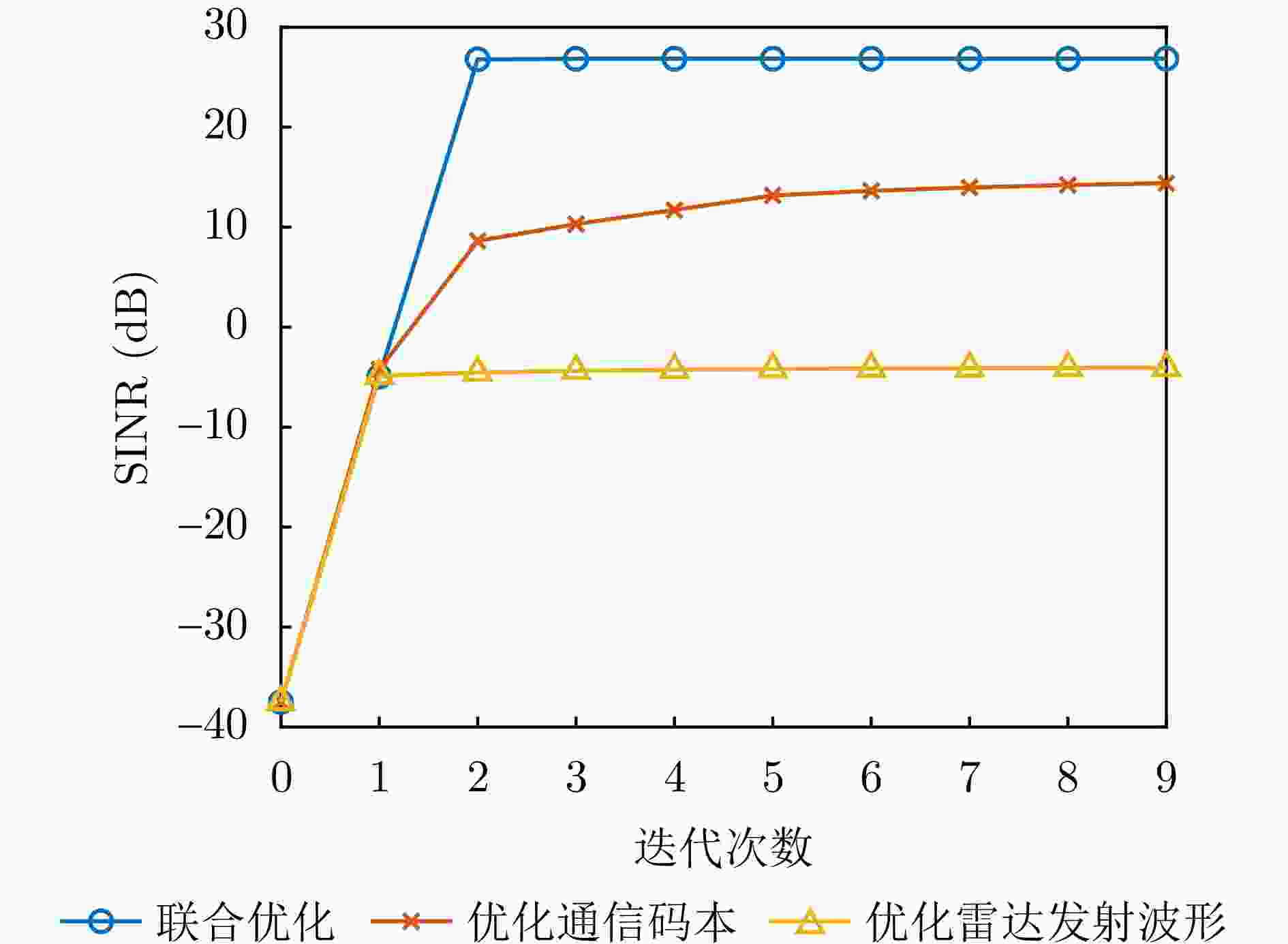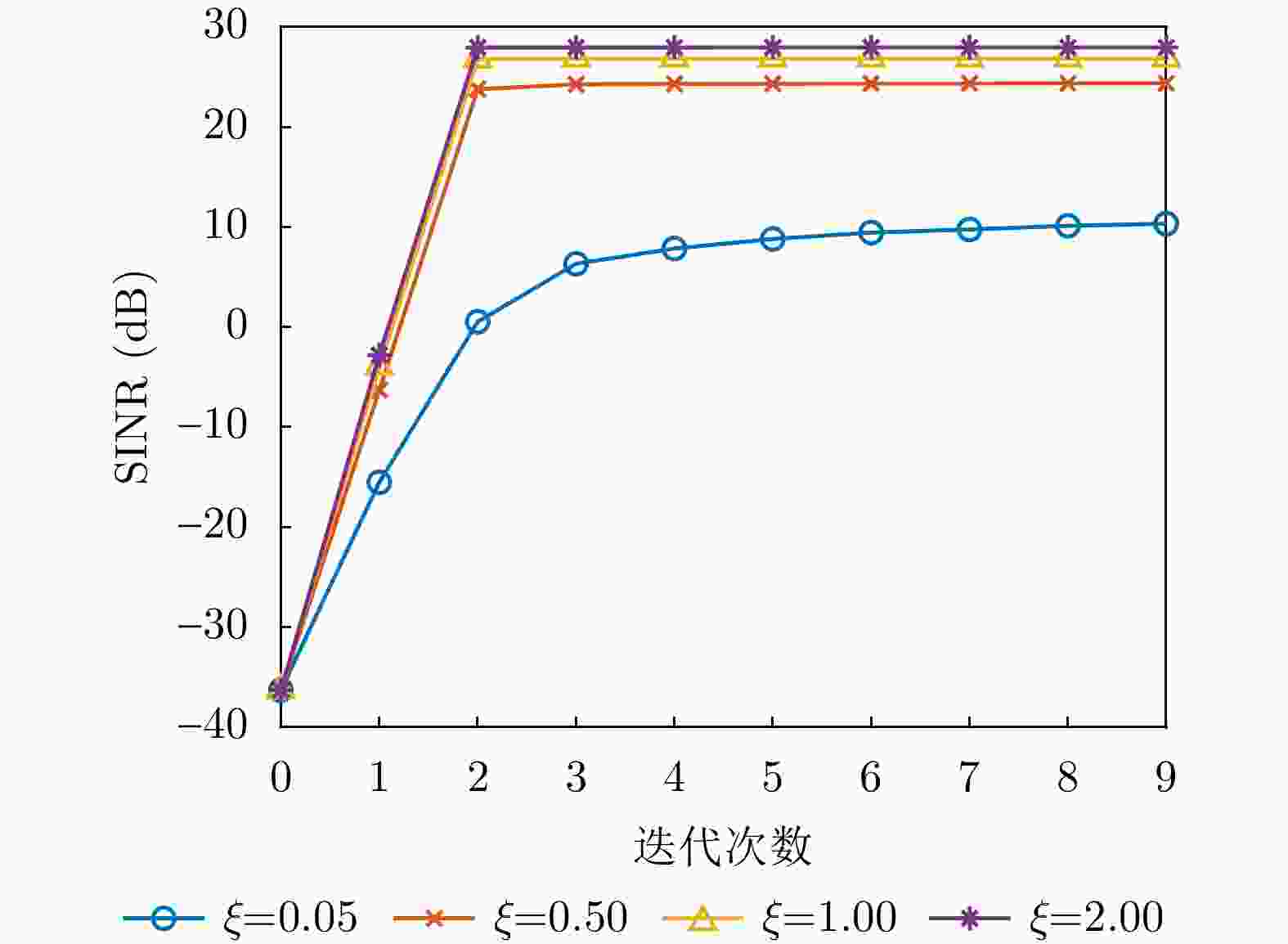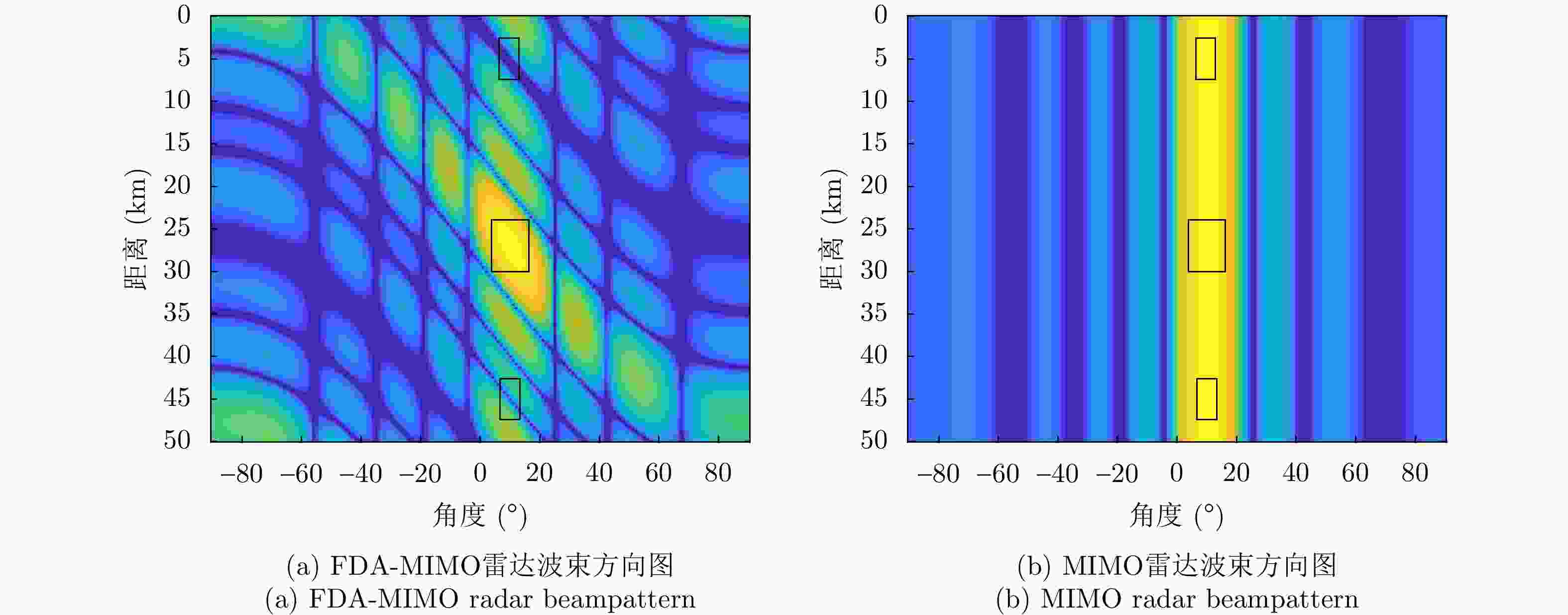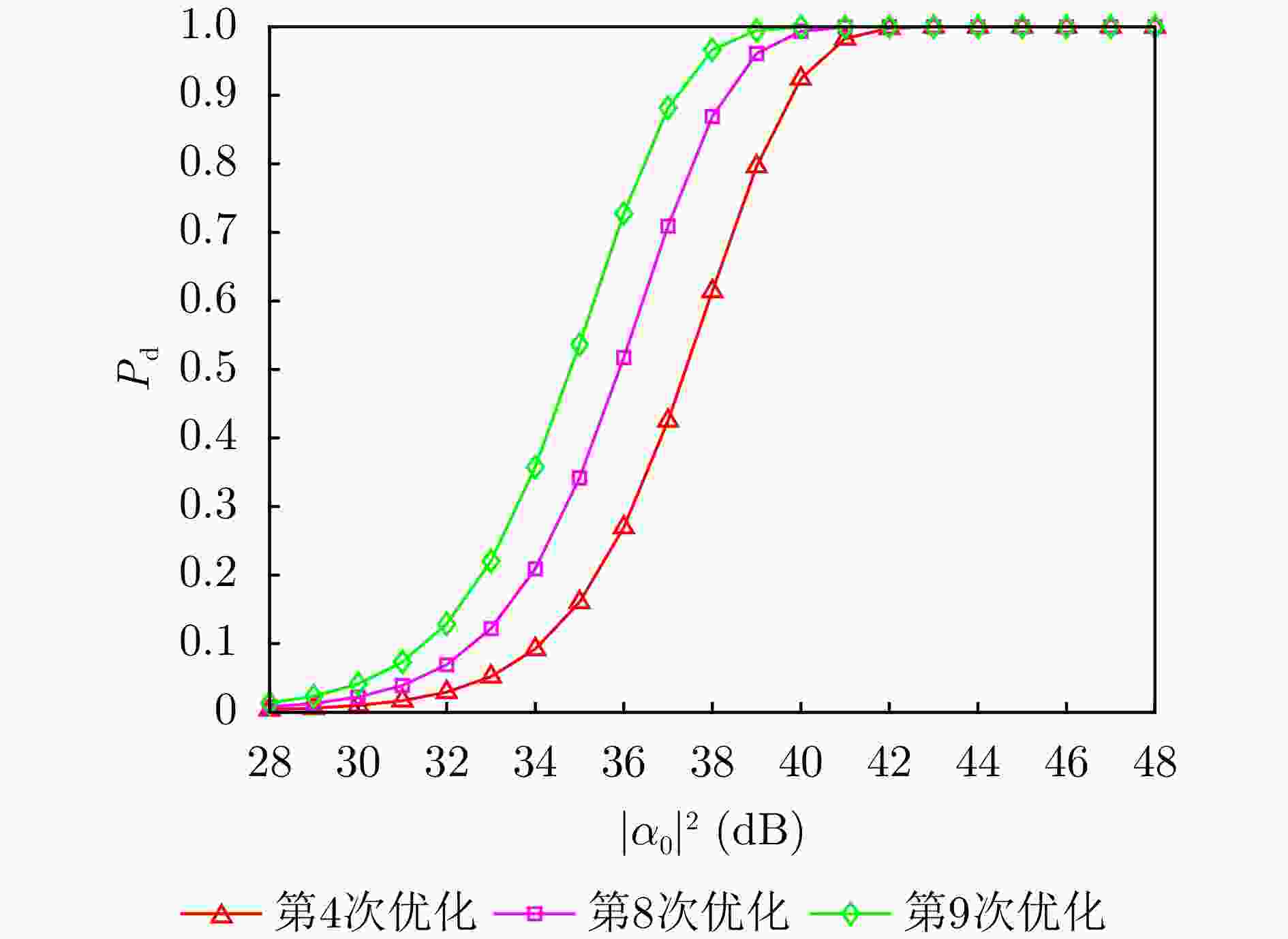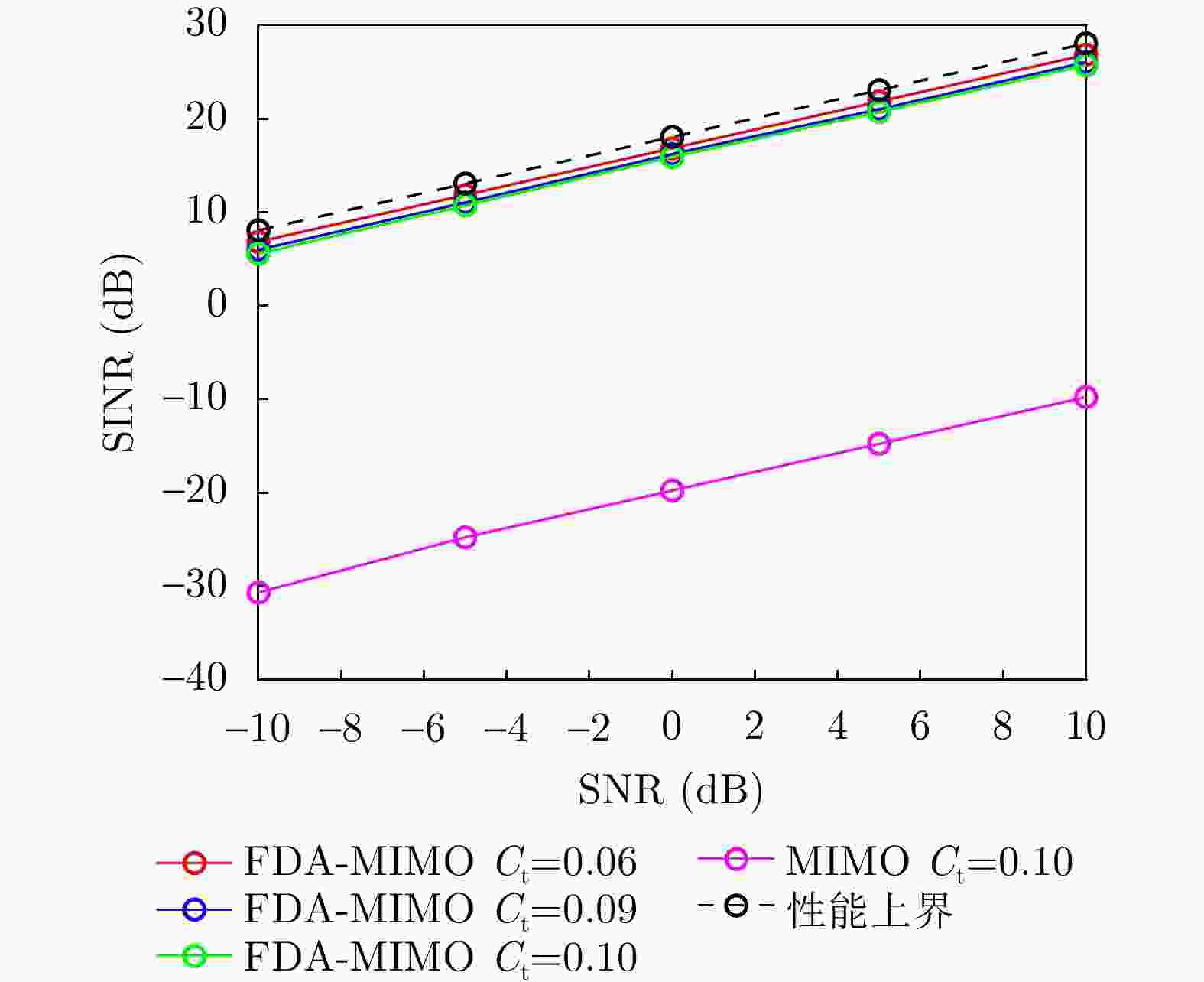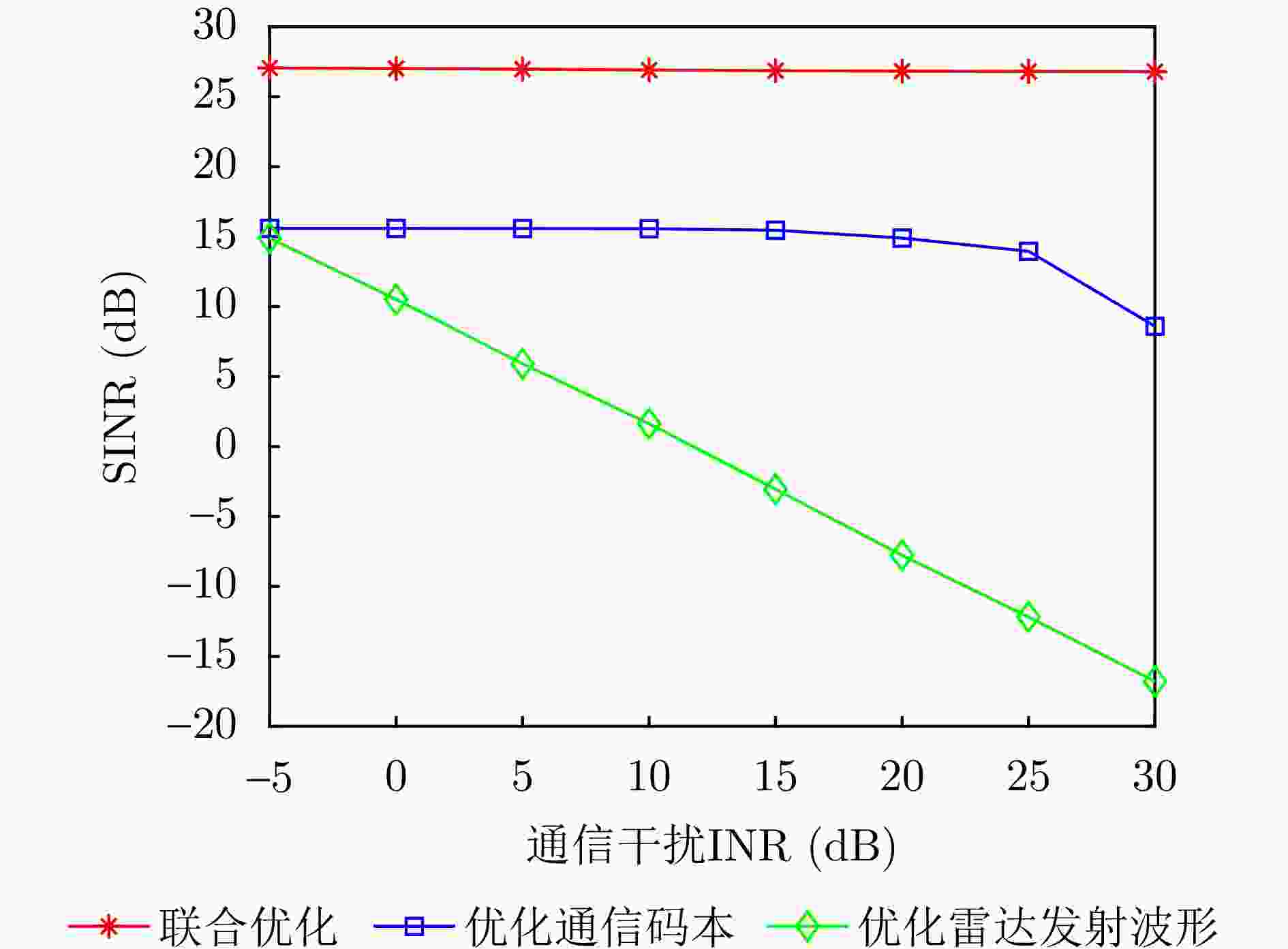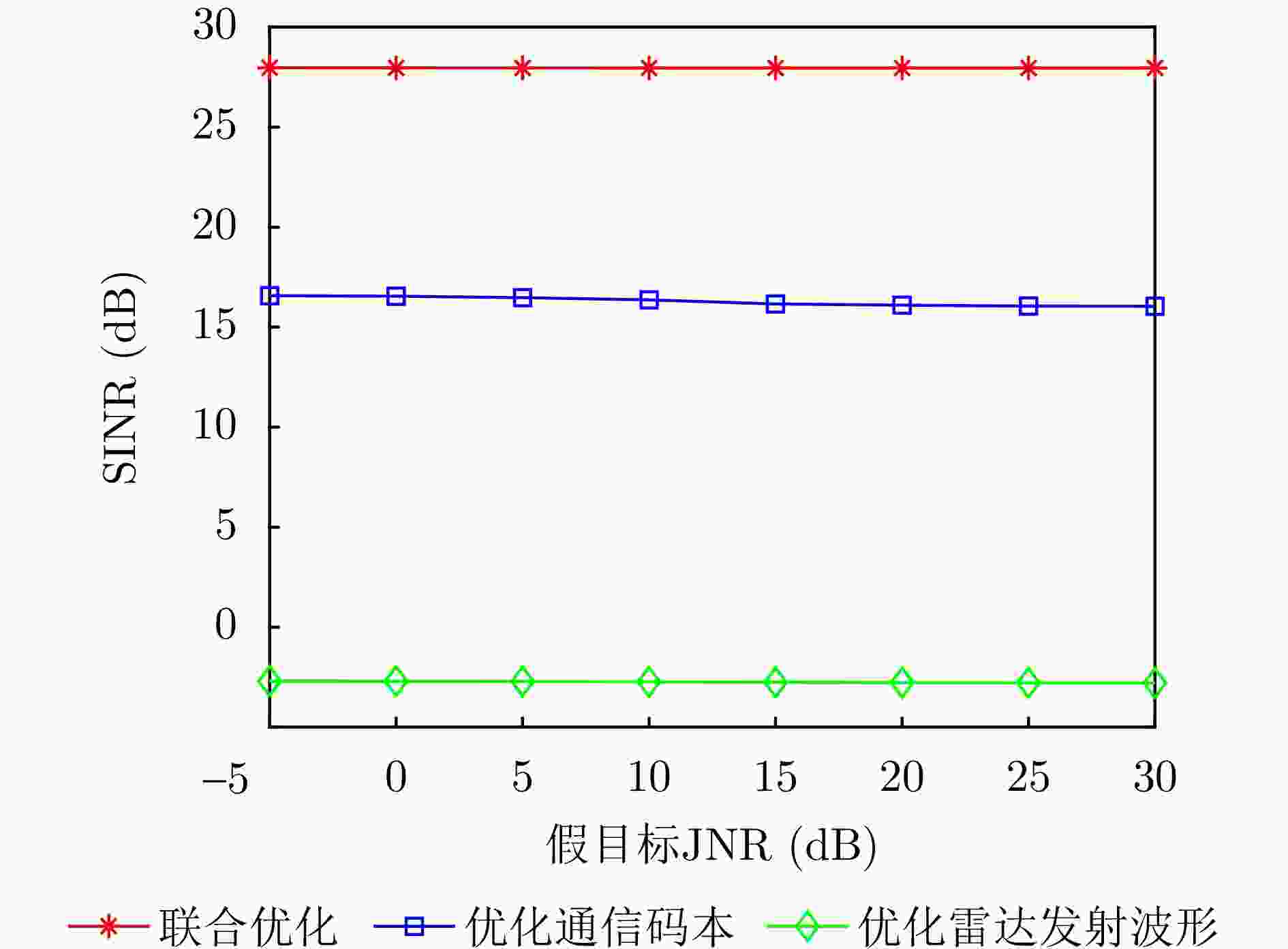Transceiver Design for an FDA-MIMO Radar and MIMO Communication Spectral Coexistence System
-
摘要: 雷达与通信在一个平台占用相同频谱时会产生相互干扰,此外雷达目标探测过程中面临主瓣方向的欺骗式干扰威胁。为解决上述问题,该文设计了一种频率分集阵多输入多输出(FDA-MIMO)雷达和MIMO通信频谱共存系统,提出了一种雷达为中心的系统收发参数联合设计方法。该方法通过联合优化雷达发射波形、雷达接收滤波器和通信发射码本,最大化雷达系统的输出信干噪比(SINR),从而提高对目标的检测概率,同时保证MIMO通信速率。在优化过程中,采用交替优化(AO)策略,将优化问题分解为多个子问题并迭代求解。其中,接收滤波器的优化通过拉格朗日乘子法求解,通信发射码本优化采用不等式定理得到最优近似解,而雷达发射波形优化通过泰勒展开和松弛算法进行凸近似。仿真结果表明,该联合设计方法能够在保证通信速率的同时有效提高雷达系统的SINR,显著提升FDA-MIMO雷达和MIMO通信频谱共存系统在主瓣欺骗式干扰下的性能。
-
关键词:
- 雷达通信频谱共存 /
- 频率分集阵多输入多输出 /
- 收发联合设计 /
- 交替优化 /
- 主瓣欺骗式干扰抑制
Abstract: When radar and communication systems share the same frequency spectrum on the same platform, mutual interference may occur. In addition, mainlobe deceptive interferences pose a serious threat to radar target detection. To address these issues, we devise a Frequency Diverse Array Multiple-Input Multiple-Output (FDA-MIMO) radar and MIMO communication spectral coexistence system and propose a radar-centric joint transceiver design scheme. In this respect, the radar transmission waveform, radar receive filter, and communication transmission codebook are optimized to maximize the Signal-to-Interference-plus-Noise Ratio (SINR) of the radar system, thereby enhancing the target detection probability while ensuring MIMO communication throughput. During the optimization process, the Alternating Optimization (AO) strategy is employed to decompose the problem into multiple subproblems, which are solved in an iterative way. Specifically, the radar receive filter is obtained using the Lagrange multiplier method. In addition, the communication transmission codebook is approximated using an inequality theorem, and the radar transmission waveform is optimized using Taylor expansion and relaxation algorithms. Simulation results reveal that this joint design method can effectively improve the SINR of the radar system while ensuring communication throughput, thereby considerably enhancing the performance of the FDA-MIMO radar and MIMO communication spectral coexistence system under mainlobe jamming conditions. -
1 基于AO的FDA-MIMO雷达和MIMO通信频谱共存系统收发联合优化算法
1. Transceiver design for FDA-MIMO radar and MIMO communication spectral coexistence system based on AO strategy
输入:${C_{\mathrm{t}}}$, ${E_{\mathrm{t}}}$, $\xi $, $\varsigma $ 初始化:$n = 0$, $ {\boldsymbol{R}}_{\text{x}}^{\left( {0} \right)} = \left( {{E_{\text{t}}}/(L{N_{\text{t}})}} \right){{\boldsymbol{I}}_{{N_{\text{t}}}L}} $, ${{\boldsymbol{s}}^{\left( 0 \right)}}$, ${{\boldsymbol{w}}^{\left( 0 \right)}}$ repeat 1.$n = n + 1$ 2.根据式(25)计算接收滤波器${{\boldsymbol{w}}^{\left( n \right)}}$ 3.使用MATLAB中的linprog函数求解问题式(34)得到通信码本
$ {\boldsymbol{R}}_{\text{x}}^{\left( n \right)} $4.使用MATLAB中的CVX工具箱求解问题式(44),再利用秩1近
似法得到雷达波形${{\boldsymbol{s}}^{\left( n \right)}}$5.计算当前${\text{SIN}}{{\text{R}}^{\left( n \right)}}$ until $\left| {{\text{SIN}}{{\text{R}}^{\left( n \right)}} - {\text{SIN}}{{\text{R}}^{\left( {n - 1} \right)}}} \right| < \varsigma $ 输出:${{\boldsymbol{w}}_{{\text{opt}}}} = {{\boldsymbol{w}}^{\left( n \right)}}$, ${{\boldsymbol{s}}_{{\text{opt}}}} = {{\boldsymbol{s}}^{\left( n \right)}}$, ${{\boldsymbol{R}}_{\text{x}}}_{{\text{opt}}} = {\boldsymbol{R}}_{\text{x}}^{\left( n \right)}$,
${\text{SIN}}{{\text{R}}_{{\text{opt}}}} = {\text{SIN}}{{\text{R}}^{\left( n \right)}}$表 1 FDA-MIMO雷达和MIMO通信频谱共存系统参数表
Table 1. FDA-MIMO radar and MIMO communication spectral coexistence system simulation parameters
参数 取值 参数 取值 载频$ {f_0} $ 1 GHz ${{\boldsymbol{H}}_{{\text{CR}}}}$路径数${P_1}$ 15 频偏$\Delta f$ 3000 Hz${{\boldsymbol{H}}_{{\text{RC}}}}$路径数${P_2}$ 15 码长L 6 目标信噪比 10 dB -
[1] YOU Xiaohu, WANG Chengxiang, HUANG Jie, et al. Towards 6G wireless communication networks: Vision, enabling technologies, and new paradigm shifts[J]. Science China Information Sciences, 2021, 64(1): 110301. doi: 10.1007/s11432-020-2955-6. [2] ZHENG Le, LOPS M, ELDAR Y C, et al. Radar and communication coexistence: An overview: A review of recent methods[J]. IEEE Signal Processing Magazine, 2019, 36(5): 85–99. doi: 10.1109/MSP.2019.2907329. [3] 刘凡, 袁伟杰, 原进宏, 等. 雷达通信频谱共享及一体化: 综述与展望[J]. 雷达学报, 2021, 10(3): 467–484. doi: 10.12000/JR20113.LIU Fan, YUAN Weijie, YUAN Jinhong, et al. Radar-communication spectrum sharing and integration: Overview and prospect[J]. Journal of Radars, 2021, 10(3): 467–484. doi: 10.12000/JR20113. [4] LIU An, HUANG Zhe, LI Min, et al. A survey on fundamental limits of integrated sensing and communication[J]. IEEE Communications Surveys & Tutorials, 2022, 24(2): 994–1034. doi: 10.1109/COMST.2022.3149272. [5] LIU Fan, CUI Yuanhao, MASOUROS C, et al. Integrated sensing and communications: Toward dual-functional wireless networks for 6G and beyond[J]. IEEE Journal on Selected Areas in Communications, 2022, 40(6): 1728–1767. doi: 10.1109/JSAC.2022.3156632. [6] 梁兴东, 李强, 王杰, 等. 雷达通信一体化技术研究综述[J]. 信号处理, 2020, 36(10): 1615–1627. doi: 10.16798/j.issn.1003-0530.2020.10.001.LIANG Xingdong, LI Qiang, WANG Jie, et al. Joint wireless communication and radar sensing: Review and future prospects[J]. Journal of Signal Processing, 2020, 36(10): 1615–1627. doi: 10.16798/j.issn.1003-0530.2020.10.001. [7] 马丁友, 刘祥, 黄天耀, 等. 雷达通信一体化: 共用波形设计和性能边界[J]. 雷达学报, 2022, 11(2): 198–212. doi: 10.12000/JR21146.MA Dingyou, LIU Xiang, HUANG Tianyao, et al. Joint radar and communications: Shared waveform designs and performance bounds[J]. Journal of Radars, 2022, 11(2): 198–212. doi: 10.12000/JR21146. [8] FOSCHINI G J. Layered space-time architecture for wireless communication in a fading environment when using multi-element antennas[J]. Bell Labs Technical Journal, 1996, 1(2): 41–59. doi: 10.1002/bltj.2015. [9] CUI Mingyao, WU Zidong, LU Yu, et al. Near-Field MIMO communications for 6G: Fundamentals, challenges, potentials, and future directions[J]. IEEE Communications Magazine, 2022, 61(1): 40–46. doi: 10.1109/MCOM.004.2200136. [10] 何子述, 程子扬, 李军, 等. 集中式MIMO雷达研究综述[J]. 雷达学报, 2022, 11(5): 805–829. doi: 10.12000/JR22128.HE Zishu, CHENG Ziyang, LI Jun, et al. A survey of collocated MIMO radar[J]. Journal of Radars, 2022, 11(5): 805–829. doi: 10.12000/JR22128. [11] 薛磊, 唐波, 李达. 面向频谱共存的MIMO雷达波形设计综述[J]. 信息对抗技术, 2023, 2(4): 70–92. doi: 10.12399/j.issn.2097-163x.2023.04-05.005.XUE Lei, TANG Bo, and LI Da. MIMO radar waveform design for spectral coexistence: An overview[J]. Information Countermeasure Technology, 2023, 2(4): 70–92. doi: 10.12399/j.issn.2097-163x.2023.04-05.005. [12] ZHANG Haoyu, CHEN Li, HAN Kaifeng, et al. Coexistence designs of radar and communication systems in a multi-path scenario[J]. IEEE Transactions on Vehicular Technology, 2024, 73(3): 3733–3749. doi: 10.1109/TVT.2023.3325544. [13] LI Da, TANG Bo, WANG Xuyang, et al. Codesign for spectral coexistence between RIS-aided MIMO radar and MIMO communication systems[J]. IEEE Transactions on Aerospace and Electronic Systems, 2024, 60(6): 8166–8183. doi: 10.1109/TAES.2024.3431514. [14] YU Xianxiang, QIU Hui, YANG Jing, et al. Multispectrally constrained MIMO radar beampattern design via sequential convex approximation[J]. IEEE Transactions on Aerospace and Electronic Systems, 2022, 58(4): 2935–2949. doi: 10.1109/TAES.2022.3150619. [15] SODAGARI S, KHAWAR A, CLANCY T C, et al. A projection based approach for radar and telecommunication systems coexistence[C]. IEEE Global Communications Conference (GLOBECOM), Anaheim, USA, 2012: 5010–5014. doi: 10.1109/GLOCOM.2012.6503914. [16] LIU Fan, MASOUROS C, LI Ang, et al. MIMO radar and cellular coexistence: A power-efficient approach enabled by interference exploitation[J]. IEEE Transactions on Signal Processing, 2018, 66(14): 3681–3695. doi: 10.1109/TSP.2018.2833813. [17] LI Bo, PETROPULU A P, and TRAPPE W. Optimum co-design for spectrum sharing between matrix completion based MIMO radars and a MIMO communication system[J]. IEEE Transactions on Signal Processing, 2016, 64(17): 4562–4575. doi: 10.1109/TSP.2016.2569479. [18] QIAN Junhui, LOPS M, ZHENG Le, et al. Joint system design for coexistence of MIMO radar and MIMO communication[J]. IEEE Transactions on Signal Processing, 2018, 66(13): 3504–3519. doi: 10.1109/TSP.2018.2831624. [19] WANG Fangzhou and LI Hongbin. Power allocation for coexisting multicarrier radar and communication systems in cluttered environments[J]. IEEE Transactions on Signal Processing, 2021, 69: 1603–1613. doi: 10.1109/TSP.2021.3060003. [20] TANG Bo and LI Jian. Spectrally constrained MIMO radar waveform design based on mutual information[J]. IEEE Transactions on Signal Processing, 2019, 67(3): 821–834. doi: 10.1109/TSP.2018.2887186. [21] QIAN Junhui, ZHANG Jinru, XU Peng, et al. Spectral coexistence for power-harvested multiuser communication system with radar[J]. IEEE Transactions on Vehicular Technology, 2024, 73(8): 12258–12263. doi: 10.1109/TVT.2024.3377892. [22] QIAN Junhui, LIU Ziyu, WANG Kezhong, et al. Transmission design for radar and communication spectrum sharing enhancement[J]. IEEE Transactions on Vehicular Technology, 2023, 72(2): 2723–2727. doi: 10.1109/TVT.2022.3207609. [23] SHI Shengnan, HE Zishu, and CHENG Ziyang. Codesign for hybrid MU-MIMO communication and MIMO radar systems based on mutual information[J]. IEEE Systems Journal, 2023, 17(1): 1328–1339. doi: 10.1109/JSYST.2022.3201773. [24] HONG Bingqing, WANG Wenqin, and LIU Congcong. Ergodic interference alignment for spectrum sharing radar-communication systems[J]. IEEE Transactions on Vehicular Technology, 2019, 68(10): 9785–9796. doi: 10.1109/TVT.2019.2933290. [25] 许京伟, 朱圣棋, 廖桂生, 等. 频率分集阵雷达技术探讨[J]. 雷达学报, 2018, 7(2): 167–182. doi: 10.12000/JR18023.XU Jingwei, ZHU Shengqi, LIAO Guisheng, et al. An overview of frequency diverse array radar technology[J]. Journal of Radars, 2018, 7(2): 167–182. doi: 10.12000/JR18023. [26] 王文钦, 陈慧, 郑植, 等. 频控阵雷达技术及其应用研究进展[J]. 雷达学报, 2018, 7(2): 153–166. doi: 10.12000/JR18029.WANG Wenqin, CHEN Hui, ZHENG Zhi, et al. Advances on frequency diverse array radar and its applications[J]. Journal of Radars, 2018, 7(2): 153–166. doi: 10.12000/JR18029. [27] 兰岚, 廖桂生, 许京伟, 等. FDA-MIMO雷达主瓣距离欺骗式干扰抑制方法[J]. 系统工程与电子技术, 2018, 40(5): 997–1003. doi: 10.3969/j.issn.1001-506X.2018.05.06.LAN Lan, LIAO Guisheng, XU Jingwei, et al. Main-beam range deceptive jamming suppression approach with FDA-MIMO radar[J]. Systems Engineering and Electronics, 2018, 40(5): 997–1003. doi: 10.3969/j.issn.1001-506X.2018.05.06. [28] 兰岚, 廖桂生, 许京伟, 等. 基于频率分集阵列的多功能一体化波形设计与信号处理方法[J]. 雷达学报, 2022, 11(5): 850–870. doi: 10.12000/JR22163.LAN Lan, LIAO Guisheng, XU Jingwei, et al. Waveform design and signal processing method of a multifunctional integrated system based on a frequency diverse array[J]. Journal of Radars, 2022, 11(5): 850–870. doi: 10.12000/JR22163. [29] LAN Lan, ZHANG Yitao, XU Jingwei, et al. Suppressing mainlobe deceptive jammers via two-low-rank matrix decomposition in FDA-MIMO radar[J]. IEEE Transactions on Aerospace and Electronic Systems, 2025, 61(2): 2885–2898. doi: 10.1109/TAES.2024.3480030. [30] LAN Lan, ROSAMILIA M, AUBRY A, et al. FDA-MIMO transmitter and receiver optimization[J]. IEEE Transactions on Signal Processing, 2024, 72: 1576–1589. doi: 10.1109/TSP.2024.3366438. [31] JIAN jiangwei, HUANG Qimao, HUANG bang, et al. FDA-MIMO-based integrated sensing and communication system with frequency offsets permutation index modulation[J]. IEEE Transactions on Communications, 2024, 72(11): 6707–6721. doi: 10.1109/TCOMM.2024.3402608. [32] JI Shilong, WANG Wenqin, CHEN Hui, et al. On physical-layer security of FDA communications over Rayleigh fading channels[J]. IEEE Transactions on Cognitive Communications and Networking, 2019, 5(3): 476–490. doi: 10.1109/TCCN.2019.2906896. [33] NUSENU S Y, SHAO Huaizong, PAN Ye, et al. Dual-function radar-communication system design via sidelobe manipulation based on FDA butler matrix[J]. IEEE Antennas and Wireless Propagation Letters, 2019, 18(3): 452–456. doi: 10.1109/LAWP.2019.2894015. [34] GONG Pengcheng, XU Kaiyan, WU Yuntao, et al. Optimization of LPI-FDA-MIMO radar and MIMO communication for spectrum coexistence[J]. IEEE Wireless Communications Letters, 2023, 12(6): 1076–1080. doi: 10.1109/LWC.2023.3261419. [35] LIU Fan, MASOUROS C, LI Ang, et al. MU-MIMO communications with MIMO radar: From co-existence to joint transmission[J]. IEEE Transactions on Wireless Communications, 2018, 17(4): 2755–2770. doi: 10.1109/TWC.2018.2803045. [36] SAYEED A M. Deconstructing multiantenna fading channels[J]. IEEE Transactions on Signal Processing, 2002, 50(10): 2563–2579. doi: 10.1109/TSP.2002.803324. [37] LIU Xiang, HUANG Tianyao, LIU Yimin, et al. Achievable sum-rate capacity optimization for joint MIMO multiuser communications and radar[C]. 2021 IEEE 22nd International Workshop on Signal Processing Advances in Wireless Communications (SPAWC), Lucca, Italy, 2021: 466–470. doi: 10.1109/SPAWC51858.2021.9593259. [38] CHEN Zihao, LIANG Junli, SONG Keman, et al. On designing good doppler tolerance waveform with low PSL of ambiguity function[J]. Signal Processing, 2023, 210: 109075. doi: 10.1016/j.sigpro.2023.109075. [39] 郝天铎, 崔琛, 龚阳, 等. 基于凸优化方法的认知雷达低峰均比波形设计[J]. 雷达学报, 2018, 7(4): 498–506. doi: 10.12000/JR18002.HAO Tianduo, CUI Chen, GONG Yang, et al. Waveform design for cognitive radar under low PAR constraints by convex optimization[J]. Journal of Radars, 2018, 7(4): 498–506. doi: 10.12000/JR18002. [40] CUI Guolong, LI Hongbin, and RANGASWAMY M. MIMO radar waveform design with constant modulus and similarity constraints[J]. IEEE Transactions on Signal Processing, 2014, 62(2): 343–353. doi: 10.1109/TSP.2013.2288086. [41] MIRSKY L. A trace inequality of John von Neumann[J]. Monatshefte für Mathematik, 1975, 79(4): 303–306. doi: 10.1007/BF01647331. [42] LUO Zhiquan, MA W K, SO A M C, et al. Semidefinite relaxation of quadratic optimization problems[J]. IEEE Signal Processing Magazine, 2010, 27(3): 20–34. doi: 10.1109/MSP.2010.936019. -



 作者中心
作者中心 专家审稿
专家审稿 责编办公
责编办公 编辑办公
编辑办公
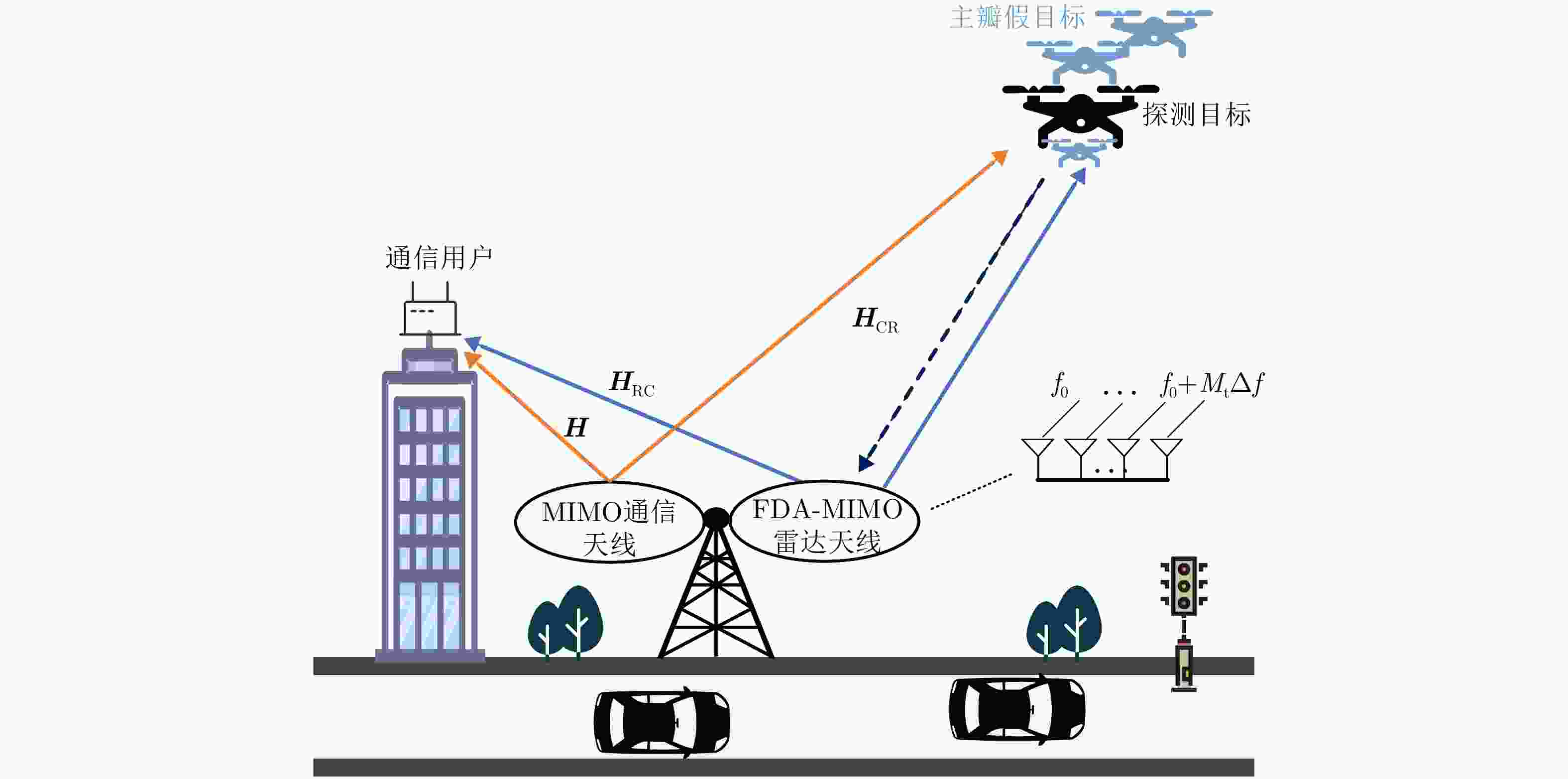
 下载:
下载:
